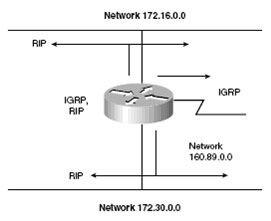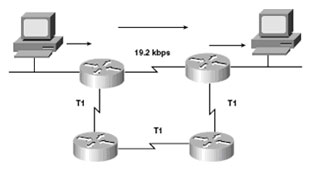In preparation of our CCNA exam, we want to make sure we cover the various concepts that we could see on our Cisco CCNA exam. So to assist you, below we will discuss Enabling RIP.
|
|
| Enabling RIP |
| |
| To enable a dynamic routing protocol, you must do the following: |
|
|
Select a routing protocol (such as RIP or IGRP). |
|
|
TAssign IP network numbers. |
|
|
Assign network/subnet addresses and the appropriate subnet mask to interfaces. The network command starts up the routing protocol. The network command also specifies a directly connected network and advertises that network. |
|
| |
 |
| |
| RIP |
| |
| Cisco devices support two versions of Routing Information Protocol (RIP): RIP Version 1 (RFC 1058) and an enhanced version, RIP Version 2, a classless routing protocol. Here are key RIP characteristics: |
|
|
RIP is a distance vector routing protocol. |
|
|
Hop count is used as the metric for path selection (the maximum is 15). |
|
|
Routing updates broadcast every 30 seconds (the default). |
|
|
RIP can load-balance over six equal-cost paths (the default is 4). |
|
|
Only one network mask can be used for each classful network (RIPv1). |
|
|
RIPv2 permits variable-length subnet masks on the internetwork. |
|
|
RIPv2 performs triggered updates. |
|
| |
| A classless routing protocol allows routers to summarize information about several routes in order to cut down on the quantity of information carried by the core routers. With classless IP configured, packets received with an unknown subnet of a directly attached network are sent to the next hop on the default route. With classless interdomain routing (CIDR), several IP networks appear to networks outside the group as a single, larger entity. |
| |
| Defining Paths |
| |
| Load balancing occurs when a router has several equal-cost paths to the same destination. Load sharing is when a router has several unequal-cost paths to the same destination. If a router has unequal-cost paths to the destination, it does not load-balance unless the variance command is used. RIPv1 doesn’t support unequal load balancing. Load balancing can be disabled by setting the maximum number of paths to 1. Here’s the procedure for configuring RIP: |
| RouterA>enable |
| RouterA#config term |
| RouterA(config)#router rip |
| RouterA(config-router)#network 10.3.2.0 |
| RouterA(config-router)#exit |
| RouterA(config)#exit |
| RouterA#show ip protocols |
|
|
show ip protocols-Shows whether a router is delivering bad routing information |
|
|
show ip route-Shows RIP routing tables |
|
|
debug ip rip-Displays RIP routing updates (no debug all disables) |
|
| Note: The network command specifies the autonomous system and starts up the routing protocol in the specified network. The network command also allows the router to advertise that network. |
| |
 |
| |
| Enabling RIP Summary |
|
|
To configure a dynamic routing protocol, select a protocol, assign a network number, and assign network addresses for each interface. |
|
|
RIP, a distance vector routing protocol, uses hop count as a route selection metric. RIP can load-balance across equal-cost paths. |
|
|
The ip classless command prevents the router from dropping packets destined for unknown subnets of directly connected networks. |
|
| |
| Continue on to the Implementing Subnet Planning Article |
| |
I hope you found this article to be of use and it helps you prepare for your Cisco CCNA certification. I am sure you will quickly find out that hands-on real world experience is the best way to cement the CCNA concepts in your head to help you pass your CCNA exam!


